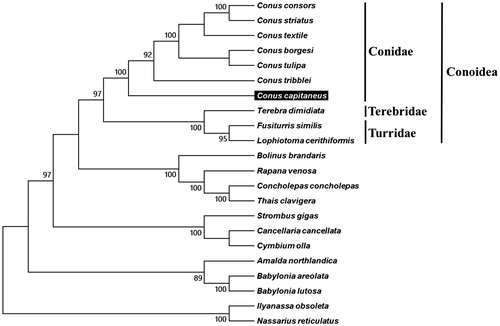Abstract
The complete mitochondrial genome sequence of cone snail Conus capitaneus, a kind of worm-hunting sea snails, was performed by next-generation sequencing. The mitogenome is 15,829 bp in length, including 13 protein-coding genes, 22 tRNA genes, 2 ribosomal RNA genes (12S and 16S rRNA) and 1 control region. It has an overall base composition of A (25.6%), T (36.6%), C (16.3%) and G (21.5%). It shows 79.8% identity with C. tribblei, which also belongs to worm-hunting sea snail. The phylogenetic analysis was conducted with 21 closely related species to assess their phylogenetic relationship. The complete mitogenome of the C. capitaneus provides important DNA molecular data for further phylogeography.
Cone snails are a highly successful group of venomous sea snails found in all the tropical oceans. They are sorted into three major groups, including piscivorous, molluscivorous and vermivorous, based on their prey preference (Olivera Citation1997; Le Gall et al. Citation1999). In this study, we present the complete mitochondrial genome sequence of C. capitaneus (Linnaeus Citation1758), a sea snail in the family Conidae, belonging to vermivorous (worm-hunting) species. They are often distributed in Indian Ocean to West Pacific Ocean areas (Röckel et al. Citation1995).
The specimens of C. capitaneus (voucher no. 20141026-001; with GenBank accession no. KX155573) in this study were collected from north coast of Taiwan (25.203N, 121.695E). They are very common species in those areas. The samples were deposited in Marine Toxins Lab., Department of Food Science, National Taiwan Ocean University, Taiwan. The total genomic DNA was extracted from muscle using magnetic bead technique with the KingFisher magnetic processors (ThermoFisher Scientific Inc., Worcester, MA). The raw next-generation sequencing reads generated from MiSeq sequencer (Illumina, San Diego, CA) were de novo assembled and reference mapping was conducted by commercial software (Geneious V9, Auckland, New Zealand) to produce a single circular form of complete mitogenome with about an average 116.7 coverage (7638 out of 8,861,884 reads, 0.086%). The complete mitochondrial genome of C. capitaneus is 15,829 bp in size, including 13 protein-coding genes, 22 tRNA genes, two ribosomal RNA genes (12S and 16S rRNA) and one control region. The overall base composition of C. capitaneus is 25.6% for A, 36.6% for T, 16.3% for C and 21.5% for G. It shows 79.8% identity with C. tribblei (KT199301), which is also a worm-hunting cone snail. The protein-coding rRNA and tRNA genes of C. capitaneus mitogenome were predicted by using MITOS (Bernt et al. Citation2013) and tRNAscan-SE (Schattner et al. Citation2005).
We used MEGA 6 (Tamura et al. Citation2013) to construct the phylogenetic relationships of the C. capitaneus and related families by Neighbour-joining method with 1000 bootstrap replicates based on the 13 protein-coding genes and 2 ribosomal RNA genes of the other 21 complete mitochondrial genomes of Neogastropoda sea snails, which are reported in GenBank of NCBI database. Bootstrap support values were relatively high, with 13 nodes having values >95% and 10 nodes demonstrating 100% bootstrap support (). C. capitaneus was grouped together with six other Conus species from the family Conidae. The lineages of Conidae strongly supported this report and agreed with previous studies (Bouchet et al. Citation2011; Puillandre et al. Citation2014).
Figure 1. Phylogenetic tree generated using the Neighbour-joining method based on complete mitochondrial genomes. C. consors (KF887950), C. striatus (KX156937), C. textile (DQ862058), C. borgesi (EU827198), C. tulipa (KR006970), C. tribblei (KT199301), C. capitaneus (KX155573), Terebra dimidiate (EU827196), Fusiturris similis (EU827197), Lophiotoma cerithiformis (DQ284754), Bolinus brandaris (EU827194), Rapana venosa (KM213962), Concholepas concholepas (JQ446041), Thais clavigera (DQ159954), Strombus gigas (KM245630), Cancellaria cancellata (EU827195), Cymbium olla (EU827199), Amalda northlandica (GU196685), Babylonia areolata (HQ416443), B. lutosa (KF897830), Ilyanassa obsoleta (DQ238598) and Nassarius reticulatus (EU827201).

Disclosure statement
Authors report no conflicts of interest. Authors alone are responsible for the content and writing of the paper.
References
- Bernt M, Donath A, Jühling F, Externbrink F, Florentz C, Fritzsch G, Pütz J, Middendorf M, Stadler PF. 2013. MITOS: improved de novo metazoan mitochondrial genome annotation. Mol Phylogenet Evol. 69:313–319.
- Bouchet P, Kantor Y, Sysoev A, Puillandre N. 2011. A new operational classification of the Conidea (Gastropoda). J Molluscan Stud. 77:273–308.
- Le Gall F, Favreau P, Richard G, Letourneux Y, Molgo J. 1999. The strategy used by some piscivorous cone snails to capture their prey: the effects of their venoms on vertebrates and on isolated neuromuscular preparations. Toxicon. 37:985–998.
- Linnaeus C. (1758). Systema Naturae per regna tria naturae, secundum classes, ordines, genera, species, cum characteribus, differentiis, synonymis, locis. Editio decima, reformata. Laurentius Salvius: Holmiae. ii.
- Olivera BM. 1997. E.E. Just Lecture, 1996. Conus venom peptides, receptor and ion channel targets, and drug design: 50 million years of neuropharmacology. Mol Biol Cell. 8:2101–2109.
- Puillandre N, Bouchet P, Duda TF Jr, Kauferstein S, Kohn AJ, Olivera BM, Watkins M, Meter C. 2014. Molecular phylogeny and evolution of the cone snails. Mol Phylogenet Evol. 78:290–303.
- Röckel D, Korn W, Kohn AJ. (1995). Manual of the living Conidae. Volume 1: Indo-Pacific Region. Germany: Verlag Christa Hemmen. p. 133–135.
- Schattner P, Brooks AN, Lowe TM. 2005. The tRNAscan-SE, snoscan and snoGPS web servers for the detection of tRNAs and snoRNAs. Nucleic Acids Res. 33:686–689.
- Tamura K, Stecher G, Peterson D, Filipski A, Kumar S. 2013 . MEGA6: molecular evolutionary genetics analysis version 6.0. Mol Biol Evol. 30:2725–2729.
